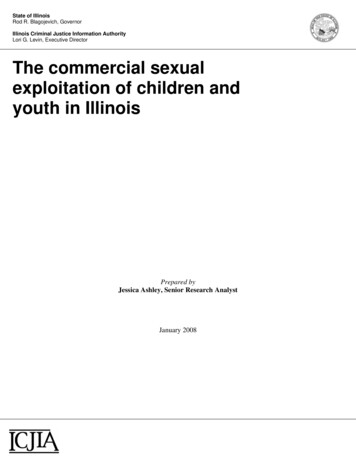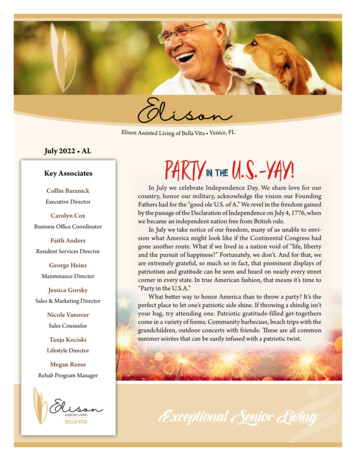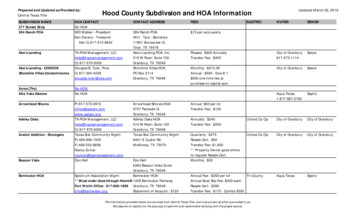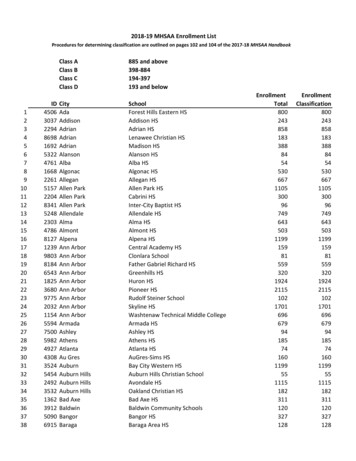
Transcription
State of IllinoisRod R. Blagojevich, GovernorIllinois Criminal Justice Information AuthorityLori G. Levin, Executive DirectorThe commercial sexualexploitation of children andyouth in IllinoisPrepared byJessica Ashley, Senior Research AnalystJanuary 2008
This project was supported by Grant #2006-JP-FX-K057 from the Department of Justice, Officeof Justice Programs, Office of Juvenile Justice and Delinquency Prevention, awarded to theIllinois Criminal Justice Information Authority. Points of view or opinions contained within thisdocument are those of the authors and do not necessarily represent the official position orpolicies of the Office of Juvenile Justice and Delinquency Prevention.Illinois Criminal Justice Information Authority120 S. Riverside Plaza, Suite 1016Chicago, Illinois 60606Telephone: 312.793.8550Fax: 312.793.8422http://www.icjia.state.il.us
AcknowledgmentsWe wish to acknowledge the assistance of those who provided data and guidance for this report,as it benefited from the guidance, support, and input of many individuals:Michael Anton, Cook County Sheriff's Police DepartmentIrvin Ashford, Circuit Court of Cook County, Juvenile Probation and Court ServicesLara Brooks, Broadway Youth CenterKenneth Burnett, Christian Community Health CentersSalvador Cicero, formerly with American Bar AssociationJudith Dunning, formerly with Department of Children and Family ServicesRachel Durchslag, Chicago Alliance Against Sexual ExploitationJudy Gall, Alternatives, Inc.Shira Hassan, Young Women's Empowerment ProjectCindy Ibarra, Young Women’s Empowerment ProjectKatherine Kirby, Chicago Crime CommissionAlan Krok, Chicago Police DepartmentJennifer Kuhn, Office of the Illinois Attorney GeneralFrank Massolini, The Salvation ArmyEmily Muskovitz Sweet, Mayor’s Office on Domestic ViolenceClaudine O'Leary, project consultantJody Raphael, DePaul University School of LawLaurie Schaffner, University of Illinois at ChicagoElissa Steglich, Heartland AllianceMark Wallschlaeger, Federal Bureau of InvestigationsAnna Wright, Cook County Juvenile Temporary Detention CenterIn addition, the project benefited from the previous and ongoing work of the Illinois CriminalJustice Information Authority’s Research and Analysis Unit. The agency would like to recognizethe support and assistance provided by the following Authority staff:Sharyn AdamsDaniel BrunnerCristin EvansErnst MelchiorMichelle Repp
Table of contentsExecutive summary.1Introduction.4Literature review.5Methodology .20Exploitation arrests in Illinois. 21Focus groups .25Law enforcement interviews.36Overall conclusions.46Final recommendations.48Appendix A: Resources .51Appendix B: Definitions .57Appendix C: Child prostitution-related crimes.59Appendix D: Focus group questions.61Appendix E: Law enforcement survey .62Notes .68
FiguresFigure 1: Number of juvenile arrests for prostitution in Illinois,1994-2004 .22Figure 2: Number of arrests for soliciting for a juvenile prostitute in Illinois,1994-2004 .23TablesTable 1: Description of perspectives on prostitution .12Table 2: Commercial sexual exploitation of children-related criminal statutesin Illinois .18Table 3: Total number of commercial sexual exploitation of children-related arrestsin Illinois, 1994-2004.24Table 4: Female focus group participants’ age of entry into sex trade.27
Executive summaryThe commercial sexual exploitation of children has received increased national attention inrecent years. Government officials have shown growing concern for young people exploited forcommercial sex. The victims are just as often U.S. citizens as they are foreign-born and secretedinto the states. Due to the hidden nature of commercial sexual exploitation of children, it isdifficult to study and quantify the problem.In the fall 2006, the Illinois Criminal Justice Information Authority was awarded a research grantby the U.S. Department of Justice Office of Juvenile Justice and Delinquency (OJJDP) to studythe commercial sexual exploitation of children. OJJDP defines commercial sexual exploitation ofchildren as a constellation of crimes of a sexual nature committed against youthful victimsyounger than 18 years old primarily or entirely for financial or other economic reasons. Thesecrimes include, for example, trafficking for sexual purposes, prostitution, sex tourism, mailorder-bride trade and early marriage, pornography, stripping, and sexual performances.Three research methods were utilized in this study, including arrest statistics, focus groups withindividuals who were prostituted as juveniles, and interviews with law enforcement officers. Theoverall goal of the research was to gain a better understanding of the commercial sexualexploitation of children and youth. Collectively, the research methods addressed the following questions: What is the incidence and prevalence of victimization? What are the pathways to victimization? What are characteristics of victims? What are the needs of exploited youth exiting exploitative situations? What are the responses of law enforcement?Commercial sexual exploitation of children is considered sex trafficking and a form of modernday slavery. The U.S. Trafficking Victims Protection Act in 2000 definition of a traffickedperson does not require the victim to be transported anywhere, and victims of trafficking can beeither American- or foreign-born. Most of these youth engage in survival sex and are runawayswho have experience childhood abuse. Female prostitutes may be controlled, intimidated,socially isolated, and economically dependent on their pimps—which may be a boyfriend,parent, or relative—making it difficult to leave a life of prostitution. Prostitutes suffer physicaland mental abuse inflicted by customers and pimps, including sexual assault, kidnapping,stabbings, beatings, and threats. Victims often suffer from physical and mental health problems,such as post traumatic stress disorder, depression, and low self-esteem.Arrest statisticsOverall, there were very small numbers of commercial sexual exploitation of children arrests inIllinois. A total of 45 arrests of juveniles for prostitution and 162 arrests for soliciting a juvenileprostitute were recorded from 1995 to 2004. During the same period, police arrested 258individuals for child pornography. However, data limitations exist, for instance, misdemeanorarrests do not require reporting.1
Focus groupsFemale focus groupOne focus group of 19 adult female participants was held on March 21. Participants were adults18 years old and older who were involved in the sex trade industry as juveniles 17 years old andyounger. Young Women’s Empowerment Project, a non-profit agency in Chicago, received asub-contract to recruit focus group participants and moderate the groups.Many of the women in the focus groups started very young in the sex trade. The average age ofentry was 12. As girls, they became involved in prostitution for basic survival needs, such asfood, clothing, and shelter, or for money and material goods. Some participants sought moneyand expensive clothing and purses to fulfill their needs for acceptance. They were oftenrunaways who left home due to family dysfunction and abuse. Some young women were forcedto perform sex acts against their will. There was agreement among focus group participants thatsocial services were not helpful to them and sometimes made things worse. Participants feltservices providers misunderstood them, misdiagnosed their problems, and stigmatized them.Transgender focus groupFive transgender individuals participated in a focus group on May 9, to discuss their experiencesin the sex trade as juveniles. The participants were recruited through collaboration with theBroadway Youth Center, a division of Howard Brown, Inc., a nonprofit agency in Chicago.Transgender refers to a range of individuals with typical gender characteristics or genderidentities that differ from their anatomic sex. Being transgender may make it difficult to findlegitimate employment, so the sex trade is seen as a choice in order to survive and make money.The age range of entry into the sex trade by transgender participants was 13-17 years old. Theparticipants talked about prostitution as a “game” or “competition,” but also a way to feelincluded and be a part of a family. Participants were victims of robbery, sexual assault, andbattery. Although some services are available for transgenders in the city of Chicago, more isneeded statewide to help the transgender population involved in trading sex, especially in thearea of employment training and placement.Law enforcement officer interviewsA total of 10 federal, state, and local law enforcement officials based in the Chicagometropolitan area were interviewed for this study from the following agencies: Federal Bureau ofInvestigations, Office of the Illinois Attorney General, Cook County State’s Attorney’s Office,Cook County Sheriff’s Department, Chicago Police Department, and police departments insuburban Chicago. During interviews, participants were asked questions about commercialsexual exploitation of children arrests and investigations, social service agencies, and the childvictims of commercial sexual exploitation. They also were asked for recommendations to combatcommercial sexual exploitation of children.2
Police officers receive tips and leads on exploitation via anonymous sources, parents, otherpolice departments, and during the course of other investigations. Officers never encountered anyinternational trafficking cases, only domestic cases of commercial sexual exploitation ofchildren. Prostituted juveniles do not aid in investigations because it is their only means, or theirfamily’s only means, of survival. Many also refuse to assist out of love or fear of their pimp.Evidence collected in investigations included computers, photographs, and records, such ascredit card bills and hotel reservations. Officers mentioned circuits of high traffic hubs for thesex trade that pimps use to transport victims, such as Detroit, Memphis, and Las Vegas, andcities in Wisconsin, and Indiana. The Internet is often used as a tool to find clients and advertiseservices, such as the popular Web site, www.craigslist.com. Child pornographers use the Internetto exchange pictures, videos, media, and Web sites. While officers work with the IllinoisDepartment of Children and Family Services and hospitals, there is no appropriate placement foryoung victims who often leave non-secure facilities such as hospitals when they have no home toreturn to.Recommendations from law enforcement officers included: Provide more resources and training to officers. Recognize that these children are victims of child commercial sexual exploitation, notoffenders. Develop more options for appropriate temporary victim placement. Increase public awareness among parents, especially on the Internet. Harsher penalties for offenders.Final recommendationsThe following are overall recommendations developed from the research study: Prevent child commercial sexual exploitation through education to at-risk youth andsupport and assistance for runaway teens. Reduce family violence to end the cycle of abuse that may lead to entry into prostitution. Identify and provide assistance for exploited youth including screening, appropriateservices, and housing. Train law enforcement officers to understand child commercial sexual exploitation and towork in conjunction with community agencies who are better equipped to aid victims. Build community capacity to reduce child commercial sexual exploitation through grantsand task forces. Keep current with technology. Change laws so juveniles are no longer arrested and prosecuted for prostitution andprescribe stiffer penalties for adult offenders who buy or sell children fro sex. Improve collaboration among entities who most often encounter exploited youth,including non-profit agencies, hospitals, and law enforcement agencies. Conduct more research on child commercial sexual exploitation to learn the extent of theproblem.3
IntroductionChild pornography and prostitution have made the commercial sexual exploitation of children amulti-million dollar industry in the U.S. Due to the attention that commercial sexual exploitationof children has received and its priority among federal, state, and local law enforcement officials,it is an important crime problem for Illinois to examine. 1 The Department of Justice’s Office ofJuvenile Justice and Delinquency Prevention considers commercial sexual exploitation ofchildren, “one of the most overlooked and egregious forms of child abuse.” The office furtherstates. “Reports from law enforcement and those concerned with child protection make it clearthe commercial sexual exploitation of children is a critical problem and that increasing numbersof children and youth are being sexually exploited through prostitution and pornography in theUnited States.” 2End Child Prostitution, Child Pornography, and Trafficking of Children for Sexual PurposesUSA (ECPAT-USA) believes youth prostitution is a complex phenomenon requiring additionalresearch to demonstrate the impact on youth and adults, and the cost to the community. 3 TheNational Center for Missing and Exploited Children concurs that a systematic effort is needed toestimate the number of youth involved in prostitution in order to understand the current need forservices. 4 A significant change has been seen in recent years in the U.S. government’s responseto sex trafficking from a concern about communities’ quality of life to concerns about victims. 5Given the changing attitudes and growing concern about child exploitation and trafficking, it isessential for those in the criminal justice system to be familiar with recent research. 6In fall 2006, the Illinois Criminal Justice Information Authority was awarded a grant from theU.S. Department of Justice, Office of Juvenile Justice and Delinquency Prevention to completeresearch on the problem of commercial sexual exploitation of children. This study utilized threeresearch methods: arrest data, interviews with law enforcement, and focus groups. Collectively,these methods facilitated the data collection on the incidence and prevalence of victimization,pathways to victimization, characteristics of victims and offenders, and the needs of youthexiting exploitative situations.4
Literature reviewNeed for commercial sexual exploitation of children researchAlthough there are moral issues surrounding commercial sex and prostitution, this researchfocuses on the sexual exploitation of minors, who, according to law, are unable to consent to sexwith adults, regardless of an economic exchange. According to the Victims of Trafficking andViolence Protection Act of 2000: Trafficking In Person’s Report, “The U.S. government policyon children under the age of 18 used for commercial sex is unambiguous. They must be removedfrom exploitation as soon as they are found. The use of children in the commercial sex trade isprohibited under both U.S. and international law. There can be no exceptions, no cultural orsocio-economic rationalizations that prevent the rescue of children from sexual servitude.” 7A 2001 University of Pennsylvania study estimated there are as many as 300,000 children at riskfor exploitation through prostitution in the United States. 8 However, there is a lack of consensuson the estimated number of sexually exploited youth. One study estimated a minimum of 16,000women and girls are regularly engage in prostitution in the Chicago metro area. 9 Another studyestimated that in Chicago 1,800 to 4,000 women and girls are involved in prostitution in theChicago area. 10 However, official statistics offer much lower estimates of the problem. TheDepartment of Justice estimated only 1,300 juveniles were arrested for prostitution in the UnitedStates in 1995; that is less than 1 percent of all juvenile arrests. 11Criminal justice statistics on the exploitation of juveniles are unreliable for many reasons. First,law enforcement assist prostituted youth rather than arrest them, and offer social services orrelease them to the custody of parents or guardians. Second, youth are often inaccuratelyprocessed as adults because they provide police with false identification or are arrested for otheroffenses such as loitering. Third, the reality is that many prostituted youth will never beidentified due to the secretive and indoor nature of prostitution.Due to the varying nature with which juvenile prostitutes are handled by law enforcement, thereare problems when relying on law enforcement data alone. Chris Swecker, assistant director ofthe FBI’s Criminal Investigative Division said, “We do not currently have a definitive numberfor the serious problem of child prostitution itself, although judges, police, and outreach workersreport both the increase in the numbers and a decrease in the ages of the children involved.Unfortunately, we know of no studies to date that specifically and primarily address juvenileprostitution. Accurately quantifying the existing problem of victimized children (as opposed to‘at risk’) is difficult for a variety of reasons. For example, in the case of children exploitedthrough prostitution, many of the prostituted youth are charged with some other offenses such assubstance abuse. Thus, data that relies on crime reports masks the true prevalence of theproblem.” 12What is commercial sexual exploitation of children?According to OJJDP, commercial sexual exploitation of children describes a constellation ofcrimes of a sexual nature committed against youth younger than 18 years old primarily or5
entirely for financial or other economic reasons. These crimes include, for example, traffickingfor sexual purposes, prostitution, sex tourism, mail-order-bride trade, and early marriage,pornography, stripping, and sexual performances. The exploitation of children by prostitution isdefined as a person under the age of 18 who engages in a sexual act or conduct in exchange formoney or anything of value. Youth serve as prostitutes, escorts, call girls, and strippers inbrothels, strip clubs, hotels, bars, and homes. In the United States only a minority of prostituteswork the streets, yet they receive the majority of attention from researchers. 13Commercial sexual exploitation is a multi-billion dollar industry based on supply and demand—demand from those who want to use children who are vulnerable in order to assert their powerand control and fulfill fantasies. Those who supply children are fueled by potential profits. Thosewho are exploited are often devastated by what is done to them and suffer from manypsychological and physical effects.Prostituted youth may not see themselves as victims until many years later and only then if theyare well out of the life of prostitution. Many believe that prostitution is their choice, a way tosurvive, or that a pimp is the only one who will love and protect them. They believe the pimp’spromises will be kept and their lives will improve. Furthermore, many suffer from physical andpsychological problems and are not equipt to acknowledge or deal with the trauma that hashappened to them.A 2001 study of prostituted youth in New York City found four trends. They include: 14 A decrease in the age of sexually exploited youth. An increase in physical and sexual violence and high-risk sex. An increase in difficulty of monitoring the number of youth because exploitation hasmoved off the streets. Insufficient services for exploited youth.TraffickingChildren who are prostituted can be trafficked either internationally or domestically for sex orlabor. International trafficking is often defined as bringing foreign children into the United Statesand domestic trafficking as moving children within the United States from state to state or city tocity for sexual purposes. 15 However, the U.S. Trafficking Victims Protection Act in 2000definition of a trafficked person does not require the victim to be transported anywhere andvictims of trafficking can be born in the United States or foreign-born. However, inexplicably,the Act currently only offers monetary assistance and services for victims of internationaltrafficking.There are varying estimates of those trafficked into the United States from other countries. TheU.S. State Department estimates that between 600,000 and 800,000 persons were traffickedacross national borders worldwide between April 2003 and March 2004. Seventy percent ofthose were trafficked for sexual exploitation and between 14,500 and 17,500 were trafficked intothe United States. 16 The CIA estimated between 18,000 and 20,000 people are trafficking intothe states each year. Underage girls from Eastern Europe or Latin America are brought intomajor cities through abduction or promises of legitimate jobs. Chicago is considered a major sex-6
trafficking hub, as are New York City, Los Angeles, and Atlanta. While U.S. victims who tradesex from money are often deplored, foreign-born youth brought to the states are viewed asinnocent victims. This report focuses on sexual exploitation of children born in the United States.Child pornographyChildren are exploited by pornography in films and magazines for personal or financial gain orfor the purposes of persuading them to participate in sex acts. Although child pornography isclassified as a commercial sexual crime, images are usually shared for free. The Internet is aneasy way for individuals to share pornographic images of children with other Internet users, andis an especially popular avenue among adult males. In addition, the Internet is used to lure youngpeople into taking and sharing pornographic pictures of themselves. Child victims ofpornography may experience physical and psychological effects, such as depression, withdrawal,and anger.There appears to be a connection between viewing child pornography and physical contact withyouth. An unreleased Bureau of Prison’s study suggests that as many as 85 percent of malesconvicted for pornography had committed acts of sexual abuse against minors, frominappropriate touching to rape. 17 Previous studies found only 30 to 40 percent of those whoviewed child pornography also commit sex acts against children.Risk factorsThere are many risk factors among those who are victims of commercial sexual exploitation.They include conflicts at home, parental neglect, physical or sexual abuse, homelessness,poverty, lack of safe and affordable housing, instability, educational failure, emotional problems,and being a runaway or forced to leave home. 18 Lacking other survival options, many must livewith the perpetrators of violence and sexual exploitation who are often their own familymembers.RunawaysIn 1999, 1.7 million youth had run away from home or were forced out. 19 This includes childrenwhose parents kicked them out of the home or whose families fell apart and there was no one tocare for them. Studies show that runaways and children who had been forced out of the homemake up 75 percent of all juvenile prostitutes. 20 One study in Canada found that a greaterpercentage of prostituted youth (87 percent) had run away from home compared to other youth(61 percent). 21 According to the National Runaway Switchboard, youth are lured intoprostitution within 48 hours of leaving home. About 75 percent of youth on the street who areidentified as runaways in the United States are from working and middle-class families. 22Juveniles living on the street develop strategies to survive. Within days or weeks of runningaway many of these girls and boys engage in survival sex in return for money, food, shelter,drugs, protection, companionship, or false promises. 23 One national survey found that 28 percentof youth on the street and 10 percent of youths in shelters reported having participated in survival7
sex for money, food, shelter, or drugs. 24 Runaways living on the street are often exploited bypredatory adults and become involved in prostitution, pornography, and drug dealing. 25Childhood abuseMost prostituted women and girls learn to tolerate abuse from being abused. Family histories ofprostituted females often include physical, sexual, and psychological abuse. 26 One study foundalmost all prostitution survivors (98 percent) reported being emotionally abused as children, 90percent were physically abused, and 85 percent were victims of incest. 27 Another study of streetprostitutes in San Francisco found that 60 percent were sexually abused as children, whichcaused physical and emotional harm, and negative attitudes toward men and sex. 28 Therefore,youth may see working on the street as a relatively safe option compared to the abuse suffered athome. 29 Sometimes the family views prostitution as normal or expected. One study of prostitutedfemales in Chicago found that more than half of those who started prostituting at a young agegrew up in a household with prostitution. 30 Family members may force children into prostitutionand in turn profit from it.RecruitmentThe InternetThe Internet is often used to exploit youth through pornography, prostitution, or sex acts. Onelarge national study of 1,500 U.S. youth found that one in seven Internet users (13 percent)received unwanted sexual solicitations or approaches in the past year. Four percent of youngInternet users received aggressive sexual solicitations in which the solicitor asked to meet inperson, called them on the telephone, or sent them mail, money, or gifts. 31Child exploiters may use the Internet because it provides: 32 Exposure to youth. Easy development of relationships. A feeling of invisibility and anonymity. Little fear of detection. Instant gratification.Exploiters can victimize children over the Internet by: 33 Enticing them for the purposes of engaging them in sex acts. Using the Internet to produce, manufacture, and distribute child pornography. Using the Internet to expose youth to pornography and encourage their participation inpornography. Enticing them for sexual tourism for commercial gain or personal gratification.Adults use popular social networking Web sites such as www.myspace.com andwww.myyearbook.com to lure youth into pornography and prostitution. Needing attention, youthmay seek out Web sites as a way to connect with others. During adolescent development, teensseek relationships and connections and are often willing to enter into voluntary sexualrelationships with adults they meet with online. Youth sometimes unknowingly communicate8
online with adults who may pose as youth and are able to be talked into exploitive situations.Youth often share private and personal information and post photographs online.Furthermore, the Internet can be used for exploitation without any physical contact with a child.Once a picture of a child is posted online it can be shared around the world. These children oftendo not know that they are victims of a crime and therefore do not disclose their victimization.Panderers and pimpsPanderers compel others to prostitute and arrange situations for people to practice prostitution inexchange for payment. Youth can be recruited for prostitution or exploitation by customers whosolicit youth directly or by peers, pimps, and other youth. They exploit vulnerable children,wining their trust and gaining control over them. These children are used for money and sex.A pimp is one who promotes and/or profits from the sale and/or abuse of another person’s bodyor sexuality for sexual purposes, or the production and/or sale images made of that person. Pimpsinclude traffickers, pornographers, brothel madams, mail-order bride agents, or call themselvesmanagers, agents, or talent directors. Pimps also may be boyfriends, relatives or familyacquaintances, owners of exotic dance services or strip clubs, or any person who makes anarrangement for
In the fall 2006, the Illinois Criminal Justice Information Authority was awarded a research grant by the U.S. Department of Justice Office of Juvenile Justice and Delinquency (OJJDP) to study the commercial sexual exploitation of children. OJJDP defines commercial sexual exploitation of










